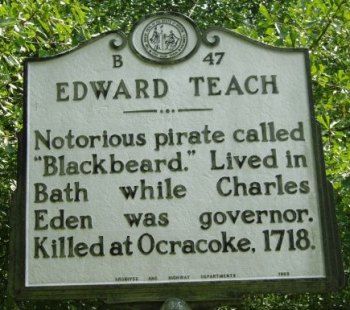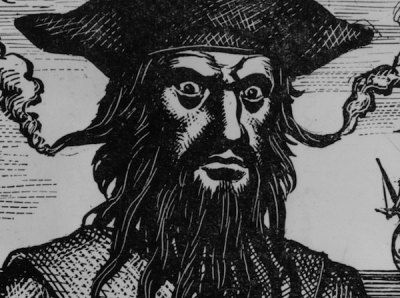Blackbeard: Man, Myth, and Legend
Before he became one of the most intimidating and ruthless pirates of all time, Edward Teach, most commonly known as Blackbeard the Pirate, sort of did things by the book. Briefly.
Born around 1680, Edward Teach – also spelled Theach, Thatch, and Thach – grew up in Bristol, England. Much is unknown about Teach until his rise to infamy, but what is known is that as young man, and like many other young Englishmen, he went to sea.
During Queen Anne’s War, which lasted from 1702 until 1713, Teach became a privateer, and saw a decent amount of war-time action. Once the war came to an end, Teach was essentially left unemployed, so in 1716 Teach joined Benjamin Hornigold’s pirate crew. Hornigold is said to be one of the most feared pirates of the Caribbean (did you see what I did there?), and after a brief period Hornigold promoted Teach to command his own vessel.
Between 1716 and 1717 the two men became a fearsome team, loathed by sailors and merchants. The pirates would corner their victims and wreak havoc on the local vessels and their crews. Sometime during 1717, Hornigold had had enough and retired from his life as a pirate. He even accepted a pardon from the King of England in 1717.
Blackbeard’s piracy career took off in a hurry, and soon he was in charge of two ships. After another pirate, Stede Bonnet, failed to do much of anything and was unable to maintain his ship the Revenge, Bonnet’s crew begged Blackbeard to take command upon seeing him in Nassau. He accepted their request and even let the failed Captain live comfortably on the Revenge. Blackbeard and his crew traveled from the Caribbean up to North America and back again. He eventually caught a third ship, La Concorde, a large French slaving ship, on which he later mounted 40 guns and renamed Queen Anne’s Revenge. The renamed vessel became his flagship, and by the end of 1717, Blackbeard had a fleet of three ships and was in command of about 150 pirates.

Blackbeard was supposedly a highly intelligent, charming, and charismatic man who preferred using intimidation over battle to gain what he wanted. A tall man, Blackbeard also had broad shoulders, which contributed to his domineering presence. When faced with an imminent battle, Blackbeard would place and ignite slow-burning fuses throughout his long black hair and beard, giving him a vicious appearance. For clothing, Blackbeard wore a large hat with a wide brim, leather boots, and long black coat. To top everything off, he went into battle with a sling of six pistols. Those who encountered him had a hard time forgetting his presence, and Blackbeard quickly developed a reputation of being ruthless.
His reputation helped him easily capture other vessels, keep them intact, and keep the cargo with minimal or no losses. He would also forcefully convince many of the captured merchants to join his fleet, many of which had valuable carpentry and medicinal skills. Generally, any ship that peacefully surrendered was looted and sent on its way with no casualties, but the same was not true for British vessels or those that set sail from Boston, where pirates were being hanged. Blackbeard and his men treated those crews especially harsh.
In the latter part of 1717 and the early part of 1718, Blackbeard and Bonnet, who was still in tow, sailed to Mexico and Central America to raid Spanish ships. The Spanish called Blackbeard “The Great Devil,” and his mission to capture and plunder the Spanish ships proved successful. During the spring of 1718, Blackbeard and his men, now totaling to about 700, returned to Nassau on four ships, where they stayed for a short time and split up the stolen cargo.
Realizing how much seamen feared him, Blackbeard and his pirates traveled to Charleston, South Carolina, to blockade the Charleston harbor. The pirates captured and robbed any sailors and ships traveling through the harbor. Once the English colonists, who had formed a thriving colony, realized who was just off shore, they were terrified. Blackbeard needed a large supply of medicine, so he sent a messenger into Charleston with his request. The colonists quickly agreed to his demands and Blackbeard received what he wanted. In about a week Blackbeard and his men left Charleston harbor.
By June of 1718, Blackbeard was exhausted and needed a break from piracy, so he grounded the Queen Anne’s Revenge and one of his smaller vessels off the North Carolina coast near Beaufort. He transferred his loot to the Adventure, abandoned most of his men, and headed for the Mainland. A short time before Blackbeard took his break, Stede Bonnet left to seek pardon. His request was denied, so he decided to return to Blackbeard. Upon discovering the abandoned men, Bonnet learned Blackbeard had not only left, but he took all the loot! Bonnet rescued the remaining men from the fleet, and they tried to locate Blackbeard, but were unsuccessful.
During this time, Blackbeard and about 20 other pirates went to see the governor of North Carolina, Charles Eden. The pirates accepted a pardon from the King, but unbeknownst to anyone, Blackbeard and Eden were making plans to work together. The two men realized they could become quite wealthy working together, so Eden agreed to officially license the Adventure, Blackbeard’s remaining vessel, to use however they wanted. The men lived on the ship in an inlet, occasionally robbing passing ships. In one instance, Blackbeard and his men seized cocoa and sugar from a passing French ship, claiming they found the goods on an abandoned vessel. He shared the stolen cargo with Governor Eden and his advisors. During his stay, Blackbeard even married a local woman, though the marriage was short-lived.

In October of 1718, another pirate, Charles Vane, and his crew sailed to North Carolina in search of Blackbeard, who was anchored in Ocracoke Inlet, just off shore of Ocracoke Island. Vane wanted to join forces with Blackbeard and reclaim the Caribbean; however Blackbeard, believing he had a good thing going with Eden, declined the offer. The encounter between the two pirates was reportedly polite, so a week of debauchery ensued on the shores of Ocracoke Island, consisting of booze, women, and feasts.
The law-abiding citizens and sailors of North Carolina grew angrier and angrier as Blackbeard continued robbing merchants with no penalties. Realizing their governor wasn’t going to stop Blackbeard from operating off the North Carolina coast, the citizens complained to Alexander Spotswood, the governor of Virginia. Governor Spotswood was not Governor Eden’s biggest fan, so he, knowing two British warships were nearby, hired 57 men from the vessels, placed them under the command of Lieutenant Robert Maynard, and charged them with finding Blackbeard.
In November of 1718, Lt. Maynard and his men sailed two ships, the Ranger and the Jane, into Ocracoke Inlet where they found Blackbeard and his men on the Adventure. Shots were fired from the Adventure, and the Ranger had to retreat due to casualties and damages. The Jane, with Lt. Maynard in command, approached the Adventure. Violent hand-to-hand combat began, with Blackbeard and Maynard each taking blows and receiving multiple wounds. Maynard shot Blackbeard twice, but the pirate continued fighting and almost killed Maynard. One of Maynard’s men delivered a fatal sword wound to Blackbeard, cutting across his throat. Almost decapitated, Blackbeard fell, and his men, upon seeing their dying leader, surrendered. Later, Lieutenant Maynard reported that Blackbeard was shot at least five times and suffered no less than 20 sword wounds. Although Maynard didn’t deliver the fatal blow to Blackbeard, he is widely credited for killing the ruthless pirate. Once word of Blackbeard’s death reached the colonies, many felt a sense of ease, and morale improved by those who were impacted by Blackbeard.
Legend has it that when Blackbeard’s headless body was thrown overboard it swam around Maynard’s vessel several times before disappearing to its watery grave (I’ve heard he swam around headless anywhere between three and seven times before finally sinking). His treasure has never been located, though a large ship was discovered in 1996 near Beaufort, which was believed to be Blackbeard’s flagship, the Queen Anne’s Revenge. The ship was positively identified in 2011 and restoration efforts are underway. Cannon, weaponry, and medical tools have all been discovered on-board, as well as hidden bits of gold.
Following Blackbeard’s death, many of his men continued their careers in piracy, joining other crews and were held in high regards. The “Golden Age of Piracy” ended in 1725, but tales of Blackbeard still live on, making him a legend and one of the most recognized pirates in history.
Editor's note: Crystal presents for us the few known facts and some filled-in details of Ocracoke's favorite pirate, Edward Teach. Most of this information is accepted by historians. But because the infamous Blackbeard's origins and adventures before he burst onto the privateering scene still belong to the murky depths of history, there are some who doubt this standard version of the story. For an alternate view of Blackbeard's identity, stop by to learn more from North Carolina historian Kevin Duffus at this weekend's festivities. (for example, Kevin posits that our favorite plunderer's real last name was Beard, and that he was born on American soil!) The full schedule for Blackbeard's Pirate Jamboree is here.




